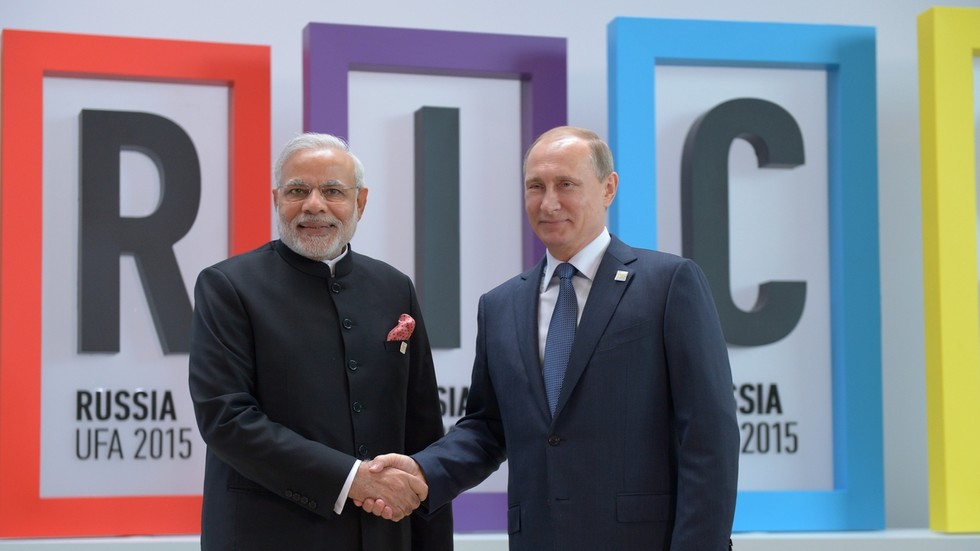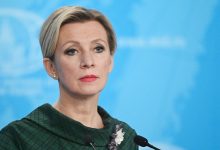
New Delhi has been strengthening ties with Moscow despite Western pressure – but to take relations to the next level, structural issues must be addressed
By Dr Arvind Gupta, Director of the Vivekananda International Foundation, New Delhi
FILE PHOTO: Indian PM Narendra Modi and Russian President Vladimir Putin. © Sergey Guneev / Host Photo Agency / Ria Novosti via Getty Images
Relations between New Delhi and Moscow have grown steadily despite the Western sanctions on Russia. Exercising its strategic autonomy, India, to the West’s disappointment, refrained from openly criticizing Russia’s military actions in Ukraine, according to Arvind Gupta, the director of New Delhi-based think tank Vivekananda International Foundation (VIF), ahead of the first Valdai Club Russian-Indian Conference, which will be held in New Delhi on January 8.
The bilateral conference, titled ‘India and Russia: Views on Alternative World Orders, Regional Problems and Bilateral Ties’ and organized by Russia’s leading think tank, the Valdai Discussion Club, in partnership with the VIF, will discuss trends in the transformation of the world order and key developments on the bilateral front.
International environment
Global tensions are currently running high and the mechanisms to resolve them have been ineffective. The ongoing Ukraine conflict and the Israel-Hamas war have exposed the international community’s inability to resolve conflicts and lessen tensions. Most multilateral mechanisms are dysfunctional as the world becomes fragmented and polarized along multiple axes.
The risk of a wider military conflagration is considerable. Arms control and disarmament mechanisms are non-existent or at a standstill. Global nuclear and missile arsenals are being expanded at a rapid pace. The risk of the weaponization of cyberspace and outer space has also increased. The indiscriminate use of sanctions as a weapon causes economic and social disruptions globally.
Read more
The unipolar moment that came about after the end of the Cold War has given way to a complex multipolar world in which Western hegemony is being increasingly challenged. The international community failed to establish a stable, equal, indivisible security system after the end of the Cold War.
In a multipolar world, a sovereign nation has many options – but there is no guarantee that a world such as this would necessarily be peaceful and stable. Russia and India, along with other countries, can and should contribute to the evolution of a peaceful, stable multipolar world based on the idea of harmony in diversity, the rule of law, cooperation, and accommodation, in which the aspirations for security and growth for all are taken into account.
New trends in bilateral ties
Indian External Affairs Minister Subrahmanyam Jaishankar’s visit to Moscow from December 25-29, 2023 reaffirmed that Indian-Russian ties remain healthy despite the current geopolitical turbulence in the world. Jaishankar was received by President Vladimir Putin, who expressed satisfaction at the state of relations and invited Prime Minister Narendra Modi to visit Russia. He said that he has kept Modi informed about the Russia-Ukraine conflict and has studied proposals made by India.
Conveying a message from Modi to Putin, Jaishankar described the relationship between the two nations as “very strong, very steady,” due to a convergence of strategic interests. The foreign ministers of the two countries also exchanged views on global and regional issues.
As the international environment changes, Russia and India are taking steps to further deepen their “special and privileged strategic partnership” which was set up in 2010. Their cooperation involves a wide range of topics, including energy, defense and security, trade and investment, education and culture, science and technology, global and regional issues, and connectivity. A strong institutional framework for bilateral exchanges has been set up.
Read more
This includes regular summit-level meetings and interactions through the India-Russia Inter-Governmental Commission on Trade, Economic, Scientific, Technological and Cultural Cooperation, as well as the India-Russia Intergovernmental Commission for Military and Technical Cooperation. Several specialized working groups have been set up.
The latest innovation is a ‘2 plus 2’ mechanism involving the defense and foreign ministers of both sides. The inaugural meeting of the group was held in Delhi in 2021. The two countries also engage with each other in the multilateral formats of the Shanghai Cooperation Organization (SCO), BRICS, RIC, G20, and the UN. India has also begun a discussion on a free trade agreement with the Eurasian Economic Union.
As a result of these measures, bilateral ties have grown stronger. Two-way trade is set to exceed $50 billion in 2023-24. Russia is now India’s fourth-largest trading partner. Both sides have also set a target of bilateral investment of $50 billion by 2025. Russia has emerged as a top supplier of crude oil to India, particularly since the beginning of the Ukraine conflict. India is a major supplier of pharmaceuticals to Russia. Russia is building six nuclear power plants in India, two of which have already been commissioned, and the other two are nearing completion.
READ MORE:
Russia-India trade to hit record high – minister
Defense cooperation has been a key pillar of Indian-Russian ties for decades. The relationship is changing from buyer-seller to a partnership in joint production and co-development of military hardware. Presently, India is producing SU30 MKI fighter aircraft and T90 tanks in India under Russian licenses.
Two joint ventures are co-producing Brahmos cruise missiles and AK203 rifles. Brahmos missiles are also being exported to third countries. India has procured the S-400 missile defense system from Russia despite US pressure. Russian companies are looking to participate in India’s ambitious ‘Make in India’ program aimed at enhancing the production of military hardware indigenously. Russia has also started exporting fertilizers to India, thus strengthening India’s food security. These are a few examples of successful cooperation in recent years.
It is noteworthy that India’s ties with Russia have grown steadily despite the Western sanctions on Russia. Exercising strategic autonomy, India, to the West’s disappointment, has not openly criticized Russia’s military actions in Ukraine. Instead, Modi conveyed to Putin that this “should not be an era of wars,” and that the conflicts should be resolved through peaceful means. Russia has shown appreciation for India’s position. Putin praised Modi for his leadership in ensuring a balanced G20 Leaders’ Declaration in which Russia was not criticized.
Read more
As Russia came under sanctions, India ramped up its purchases of Russian crude oil. India was criticized heavily by Western countries. Had Russian oil been taken off the international market, global oil prices would have skyrocketed. Following an independent foreign policy, India has continued to buy Russian oil. This has had a triple effect – the Indian economy has benefitted from relatively cheaper Russian oil, the Russian economy was able to survive the Western sanctions, and global oil prices have remained stable, thereby protecting the world from rampant inflation.
India and Russia have a long tradition of cooperation in science and technology, particularly in space and defense. Moscow is working with New Delhi on the Gaganyaan human spaceflight program. High technology cooperation between the two countries has good potential. India is now a major technological power in the world. Both India and Russia have launched major programs in artificial intelligence and quantum computing. Projects of a commercial and strategic nature can be developed in areas of emerging technologies. India can also benefit by sourcing critical minerals from Russia needed to enter the era of electric vehicles.
In 2019, India formulated its Act Far East policy to focus on Russia’s resource-rich and relatively underdeveloped Far East region. The two countries decided to build maritime connectivity between Chennai and Vladivostok, passing through the Indian and Pacific Oceans. New Delhi announced a soft credit line of $1 billion to encourage Indian investments in Russia’s Far East, which will lessen Russia’s anxieties about India’s involvement in the Indo-Pacific.
Russia is a major player in the Arctic, with around 5,600 kilometers of coastline along the North Sea Route, which has opened up for summer passage due to the thawing of the Arctic Ocean on account of global warming. Although the Arctic is a sensitive region geopolitically, India cannot ignore this area. New Delhi announced an Arctic policy in 2022, and Moscow can be an important partner in implementing it.
READ MORE:
Western ‘mistakes’ giving rise to trade alternatives – Lavrov
Despite these positive developments in bilateral relations, it must be acknowledged that the potential of Indian-Russian ties has remained underdeveloped due to a lack of connectivity between the two countries. In this regard, the importance of the International North-South Transport Corridor (INSTC), which would connect India with Russia through Iran, cannot be overestimated. The project, which began over 20 years ago, is likely to be formally launched soon. This connectivity will have major impact on Indian-Russian trade ties. India has proposed linking up the Chabahar Port in Iran, where it has some investments, with the INSTC.
Geopolitics
Although both sides have managed the current global turbulence reasonably well, they should remain alert to the fact that the geopolitical factors are uncertain and can have an unexpected impact on bilateral relations. A sound appreciation of each other’s security concerns is needed. India has deep strategic interests but also security vulnerabilities in Eurasia, as well as the vast Indo-Pacific region. Russian security is closely tied up with Europe, the Balkans, the Middle East, Afghanistan, and the Eurasian regions. Both countries are affected by issues of terrorism, radicalization, and instability in Afghanistan.
Read more
After the events of 2014, which marked the start of Ukraine conflict, and February 2022, Russia is now unmistakably pivoting towards the east. As the latest Russian foreign policy concept shows, the prominence of China and India in Russian foreign policy has increased, while its relations with the US and Europe have been on the decline.
India-China relations were adversely impacted by clashes in Eastern Ladakh in the Galwan region in 2020. This comes at a time when Russia-China ties have become more strategic, particularly after the start of the Ukraine conflict. Thus, Russia and India have a different lens through which they perceive China. Likewise, Russia and China have different perceptions about the US and the West in general.
In Russian strategic circles, there is some anxiety over the perceived Indian ‘tilt’ towards the West. The fact is that India follows an independent foreign policy guided by strategic autonomy. India’s participation in the Quad, a grouping of the US, Japan, Australia, and India in the Indo-Pacific region, is seen in Russia with anxiety. Likewise, Russia’s growing strategic closeness with China and Pakistan cause some concern in India. Both sides need to have a proper assessment of each other’s strategic priorities and concerns.
Way forward
To give further impetus to bilateral ties, it is important that the tradition of annual summits between the leaders of India and Russia, which was interrupted in 2022, is restored. There are some structural issues the two sides need to address to take relations to the next level.
Read more
Russia and India need to assure each other that their relations with third countries do not impact bilateral relations adversely. It is crucial to have regular contacts at the highest levels to understand each other’s positions on key global and regional issues. India has called for a reformed multilateralism and democratization of the UN system. Both countries can work together in this vital area. India is also actively taking up the issues of Global South. The expansion of BRICS into BRICS-plus offers an opportunity for them to shape the organization in a new environment. Likewise, India and Russia can coordinate their positions in the SCO and G20.
Following the imposition of Western sanctions on Russia, payment mechanisms to settle trade transactions have been found to be inadequate. Although India has purchased large quantities of Russian oil, stable payment mechanisms have yet to be formulated. This issue must be addressed urgently and creatively so that bilateral ties are not affected adversely. Similarly, the two sides should conclude a bilateral investment protection treaty soon to facilitate investments. Non-tariff barriers to trade should also urgently be removed. The relationship between their banks and insurance companies are inadequate and underdeveloped. These issues need to be resolved to buttress the trade and economic potential of the two sides.
READ MORE:
‘India is a superpower!’ How the most populous country on Earth reacted to the success of its historic Moon mission
India’s Russian partners should appreciate how much the country has changed in the last ten years. The Indian economy, among the fastest growing in the world, is growing at over 7% per year. Its GDP is approaching the $4 trillion level. Joining a select group of spacefaring nations, it has landed a rover near the south pole of the Moon. It has emerged as a leading nation in the use of digital technologies for payment systems. It is the largest supplier of vaccines in the world. It has emerged as a major welfare state in the world, with 800 million people being provided grain free of cost up to 2029. A third of the Indian population is covered by relatively inexpensive health insurance. India’s experience of using technology in development offers a model for the Global South, and is sharing this experience – which could prove to be crucial in the creation of a multipolar world.
India has an ambitious target of installing 500 GW of renewable energy by 2030. Presently, it has a combined renewable energy installed capacity of 180 GW, which includes 44.5 GW of wind power and 72.3 GW of solar power. India took the lead in setting up the International Solar Alliance (ISA) in 2015, which now has 110 members, and a Coalition for Disaster Resilient Infrastructure (CDRI), with 39 members.
Read more
Both ISA and CDRI focus on climate change and its impact. India’s per capita emissions of greenhouse gases are far below the global average level. Indian advances in emerging technologies and clean and green energy offer opportunities for Russia and India to explore cooperation in emerging areas. New Delhi and Moscow have signed new long-term programs of cooperation in defense, as well as science and technology. Thus, a framework exists to explore new areas of cooperation. It will be important to involve the private sector, academics, think tanks, and public organizations in these areas.
It is necessary to strengthen individual contacts between the two countries, particularly among young people. Russia has a rich tradition in the field of Indology. This must be revived. Russian academics could focus more attention on India’s 5,000-year-old civilization, going back to the Indus-Saraswati Civilization. The vast treasure of Indian strategic thinking, culture, and civilization needs to be approached from a non-Western, non-colonial perspective.
Likewise, Indian institutions of higher learning should pay greater attention to Russia, its history, culture, and civilization. There needs to be joint programs of research, studies, and dissemination among experts on both sides. Indian academics have regularly participated in high-level conferences organized by prominent think tanks such as the Valdai Discussion Club. These types of contacts should be expanded.
During its G20 presidency, India put forward the civilizational idea of ‘Vasudhaiva Kutumbakam’, a vision of one planet, one world, and one future. This vision recognizes multiplicity, plurality, and diversity in the world, envisioning a world of mutual cooperation, accommodation, caring and sharing, respect for nature, the environment, and biodiversity. A multipolar world requires this type of inclusive vision – otherwise, there will be chaos. Both India and Russia are in a unique position to contribute to the emergence of a harmonious, peaceful, and stable multipolar world.
The statements, views and opinions expressed in this column are solely those of the author and do not necessarily represent those of RT.




